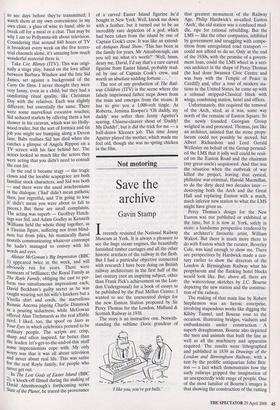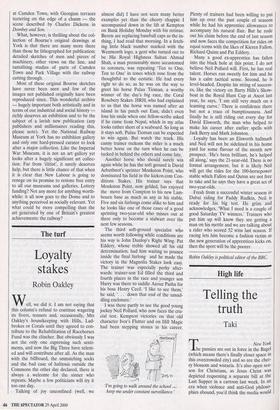Not motoring
Save the
archive
Gavin Stamp
recently revisited the National Railway Museum at York. It is always a pleasure to see the huge steam engines, the beautifully furnished timber carriages and all the other historic artefacts of the railway in the flesh. But I had a particular objective connected with research I have been doing on British railway architecture in the first half of the last century (not an inspiring subject, other than Frank Pick's achievement on the Lon- don Underground) for a book of essays to be published by the Paul Mellon Centre: I wanted to see the unexecuted design for the new Euston Station proposed by Sir Percy Thomas for the London, Midland & Scottish Railway in 1938.
The story is an instructive one. Notwith- standing the sublime Doric grandeur of 'I like you, you've got balls.' that greatest monument of the Railway Age, Philip Hardwick's so-called Euston 'Arch', the old station was a confused mud- dle, ripe for rational rebuilding. But the LMS — like the other companies, inhibited by government and struggling with compe- tition from unregulated road transport — could not afford to do so. Only at the end of the 1930s, with the promise of a govern- ment loan, could the LMS wheel in a seri- ous architect in the shape of Percy Thomas (he had done Swansea Civic Centre and was busy with the Temple of Peace in Cardiff" .a,nd, after a tour of modem sta- tions in the United States, he came up with a colossal stripped-Classical block with wings, combining station, hotel and offices.
Unfortunately, this required the removal of the Arch, sited, as it was, some way north of the remains of Euston Square. So the newly founded Georgian Group weighed in and protested. Thomas, just like an architect, insisted that the stone propy- laeum could not possibly be moved, but Albert Richardson and Lord Gerald Wellesley on behalf of the Group persuad- ed the LMS that it jolly well could be resit- ed on the Euston Road and the chairman (my great-uncle) acquiesced. And that was the situation when the outbreak of war killed the project, leaving that cynical, philistine war-criminal, Harold Macmillan, to do the dirty deed two decades later — destroying both the Arch and the Great Hall and replacing Euston with a much, much inferior new station to what the LMS might have given us.
Percy Thomas's design for the New Euston was not published or exhibited at the time, but it is now at York, safely in store: a handsome perspective rendered by the architect's favourite artist, William Walcot. But there is much more there to do with Euston which the curator, Beverley Cole, was kind enough to show me. There are perspectives by Hardwick made a cen- tury earlier to show the directors of the London & Birmingham Railway what his propylaeum and the flanking hotel blocks would look like. But, above all, there are the watercolour sketches by J.C. Bourne depicting the new station and the construc- tion of the railway.
The making of that main line by Robert Stephenson was an heroic enterprise, involving stupendous works like digging the Kilsby Tunnel, and Bourne rose to the occasion, illustrating bridges, viaducts and embankments under construction. A superb draughtsman, Bourne also depicted the men and animals that built the line as well as all the machinery and apparatus required. The results were lithographed and published in 1839 as Drawings of the London and Birmingham Railway, with a text by the prolific antiquarian John Brit- ton — a fact which demonstrates how the early railways gripped the imagination of an unexpectedly wide range of people. One of the most familiar of Bourne's images is that showing the construction of the cutting at Camden Town, with Georgian terraces teetering on the edge of a chasm — the scene described by Charles Dickens in Dombey and Son.
What, however, is thrilling about the col- lection of Bourne's original drawings at York is that there are many more there than those he lithographed for publication: detailed sketches of men and pieces of machinery, other views on the line, and tantalising studies of parts of Camden Town and Park Village with the railway cutting through.
Most of these original Bourne sketches have never been seen and few of the images not published originally have been reproduced since. This wonderful archive — hugely important both artistically and in terms of our industrial and social history — richly deserves an exhibition and to be the subject of a lavish new publication (any publishers and millionaires reading this, please note). Yet the National Railway Museum at York has no exhibition gallery and only one hard-pressed curator to look after a major collection. Like the Imperial War Museum, it is not an art gallery yet looks after a hugely significant art collec- tion. Far from 'elitist', it surely deserves help, but there is little chance of that when it is clear that New Labour is going to renege on its promise to restore free entry to all our museums and galleries. Lottery funding? Not any more for anything worth- while: it all now goes to the Dome and to anything perceived as socially relevant. Yet what could be more compelling than the art generated by one of Britain's greatest achievements: the railway?



























































 Previous page
Previous page